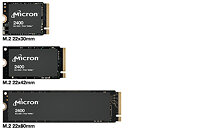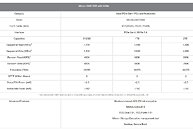- Joined
- Oct 9, 2007
- Messages
- 47,233 (7.55/day)
- Location
- Hyderabad, India
| System Name | RBMK-1000 |
|---|---|
| Processor | AMD Ryzen 7 5700G |
| Motherboard | ASUS ROG Strix B450-E Gaming |
| Cooling | DeepCool Gammax L240 V2 |
| Memory | 2x 8GB G.Skill Sniper X |
| Video Card(s) | Palit GeForce RTX 2080 SUPER GameRock |
| Storage | Western Digital Black NVMe 512GB |
| Display(s) | BenQ 1440p 60 Hz 27-inch |
| Case | Corsair Carbide 100R |
| Audio Device(s) | ASUS SupremeFX S1220A |
| Power Supply | Cooler Master MWE Gold 650W |
| Mouse | ASUS ROG Strix Impact |
| Keyboard | Gamdias Hermes E2 |
| Software | Windows 11 Pro |
Micron Technology, Inc., today announced it has begun volume shipments of the world's first 176-layer QLC NAND SSD. Built with the most advanced NAND architecture, Micron's 176-layer QLC NAND delivers the industry's leading storage density and optimized performance for a broad range of data-rich applications. Designed for use cases spanning client and data center environments, Micron's transformative new NAND technology is now available with the introduction of the Micron 2400 SSD, the world's first 176-layer PCIe Gen4 QLC SSD for client applications. The new 176-layer QLC NAND will also be incorporated into select Micron Crucial consumer SSDs, and available as a component for system designers.
Micron's groundbreaking 176-layer QLC NAND provides a layer count and density unprecedented in QLC NAND flash and follows Micron's delivery of the industry's first 176-layer TLC NAND. Additionally, Micron's 176-layer QLC NAND enables 33% higher I/O speed and 24% lower read latency than Micron's prior generation solution. Its replacement-gate architecture is the only mass production QLC flash storage that combines charge trap with a CMOS-under-array design. These improvements are driving adoption of QLC SSDs in the client PC market, which is expected to triple QLC adoption by 2023, exceeding 35%, and reaching nearly 80% bit share in 2025.

"Micron's 2400 SSD builds upon our 176-layer NAND industry leadership to drive the transition to QLC-based storage for the client market," said Jeremy Werner, corporate vice president and general manager of Micron's Storage Business Unit. "Furthering our market leadership, we expect the new 2400 PCIe Gen4 SSD will significantly accelerate the adoption of QLC in client devices as it enables broader design options and more affordable capacity."
QLC NAND SSD for everyday computing
The Micron 2400 SSD delivers industry-leading storage density in a mainstream, value NVMe SSD to enable flexible OEM solution design and provide an uncompromising user experience. With 176-layer NAND and PCIe Gen4 technologies combined, the 2400 SSD doubles the performance of Micron's previous generation client SSD and delivers 23% faster read time for accelerated boot and load times.
The Micron 2400 SSD is also the world's only 2 TB 22x30mm M.2 SSD. This form factor shrinks the physical space required by 63% when compared with a 22x80mm M.2 form factor, providing design flexibility and making the drive ideal for small, mobile laptop designs. It is also available in 22x42mm and 22x80mm M.2 form factors, all with common firmware to minimize design qualification efforts.
The 2400 SSD provides a robust user experience across diverse use cases enabled in part by Micron's Host Memory Buffer technology that allows the host to flexibly optimize performance. The SSD features low-power consumption for all-day, untethered computing, with active idle power being reduced by 50% from Micron's previous generation solution. The Micron 2400 SSD is designed to meet Intel Project Athena requirements, enabling more than nine hours of real-world battery life on laptops even when using high-definition displays.

For more information, visit this page.
View at TechPowerUp Main Site
Micron's groundbreaking 176-layer QLC NAND provides a layer count and density unprecedented in QLC NAND flash and follows Micron's delivery of the industry's first 176-layer TLC NAND. Additionally, Micron's 176-layer QLC NAND enables 33% higher I/O speed and 24% lower read latency than Micron's prior generation solution. Its replacement-gate architecture is the only mass production QLC flash storage that combines charge trap with a CMOS-under-array design. These improvements are driving adoption of QLC SSDs in the client PC market, which is expected to triple QLC adoption by 2023, exceeding 35%, and reaching nearly 80% bit share in 2025.

"Micron's 2400 SSD builds upon our 176-layer NAND industry leadership to drive the transition to QLC-based storage for the client market," said Jeremy Werner, corporate vice president and general manager of Micron's Storage Business Unit. "Furthering our market leadership, we expect the new 2400 PCIe Gen4 SSD will significantly accelerate the adoption of QLC in client devices as it enables broader design options and more affordable capacity."
QLC NAND SSD for everyday computing
The Micron 2400 SSD delivers industry-leading storage density in a mainstream, value NVMe SSD to enable flexible OEM solution design and provide an uncompromising user experience. With 176-layer NAND and PCIe Gen4 technologies combined, the 2400 SSD doubles the performance of Micron's previous generation client SSD and delivers 23% faster read time for accelerated boot and load times.
The Micron 2400 SSD is also the world's only 2 TB 22x30mm M.2 SSD. This form factor shrinks the physical space required by 63% when compared with a 22x80mm M.2 form factor, providing design flexibility and making the drive ideal for small, mobile laptop designs. It is also available in 22x42mm and 22x80mm M.2 form factors, all with common firmware to minimize design qualification efforts.
The 2400 SSD provides a robust user experience across diverse use cases enabled in part by Micron's Host Memory Buffer technology that allows the host to flexibly optimize performance. The SSD features low-power consumption for all-day, untethered computing, with active idle power being reduced by 50% from Micron's previous generation solution. The Micron 2400 SSD is designed to meet Intel Project Athena requirements, enabling more than nine hours of real-world battery life on laptops even when using high-definition displays.

For more information, visit this page.
View at TechPowerUp Main Site



 What about Crucial? I thought they were one and the same company. Or is it some kind of illusion of internal competition like with Coca-Cola and Fanta?
What about Crucial? I thought they were one and the same company. Or is it some kind of illusion of internal competition like with Coca-Cola and Fanta?

 As long as it's nvme, you don't feel the difference anyway.
As long as it's nvme, you don't feel the difference anyway.